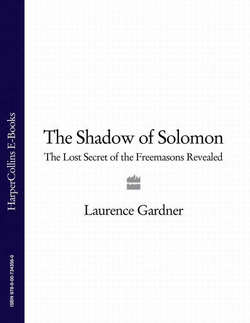Читать книгу The Shadow of Solomon: The Lost Secret of the Freemasons Revealed - Laurence Gardner - Страница 18
Heresy
ОглавлениеSo, what was Christopher Wren’s ‘old school’ of masonry? The picture comes together easily by looking at those few men of his acquaintance whom we have met already: King Charles II, Sir Robert Moray and Elias Ashmole—Freemasons all, but what was their communal meeting ground? It was the Royal Society at Gresham College in London. The Royal Society was, and is, a scientific academy for the purpose of studying natural philosophies. Freemasonry had the very same objectives and, even today, the ritual makes it clear that members are encouraged to ‘devote time to the study of such liberal arts and sciences as may be within the compass of your attainments’.
Although Freemasonry is a secretive society, this does not mean that the secrets held amount to anything that would benefit any outsider to discover. All lodge ceremonies and rituals are scripted and rigorously repetitive. Nearly everything in those rituals is publicly available. The secrets are nothing more than the signs, tokens and passwords of recognition by way of which one mason knows the degree status of another. These words and definitions are left as blanks in the published rituals—and that is the full extent of it.
The Liberal Arts (see page 23) are not taught as subjects within the lodge environment, they are only alluded to. Neither are the sciences (as cited in the lodge dialogue), nor any natural philosophies taught or discussed. There are allegorical, illustrated lectures which point members towards an awareness of spiritual and philosophical enlightenment, but there is no practical instruction given. The lectures are delivered by way of rote, not by way of any qualified professional experience, and the lectures for each grade are not based on any ongoing research. They are fixed, rigid and the same, word-for-word, time after time. Thus, what it all amounts to these days is a ‘role play’, a costumed re-enactment of operating procedures that were followed in lodges at a time when new material was introduced and debated at each meeting. Freemasonry today exists as a framework for something that used to be a cumulative and progressive work experience. But the only ‘work’ necessary for lodge performance these days is that of learning scripted text off by heart.
Outside the formal lodge environment, in what are styled the ‘private assemblies’ (such as around the dinner table, or ‘festive board’ as it is called), it is stated in lodge instruction that a member may ‘offer opinions on such subjects as are regularly introduced in our lectures’. The claim is that this ‘privilege’ enables one to ‘strive through researching the more hidden paths of nature and science’. But in my own experience of some 20 years of lodge attendance, I never heard anyone discussing nature or science. Moreover, if one were to make a headline discovery that rocked the world of science and changed the course of history, it would not make one iota of difference to the lodge workings. The basic precepts in such matters have been fixed (albeit loosely) since the revisions of United Grand Lodge were introduced in 1816. The most up-to-date scientific statement in modern Craft ritual is that the Earth revolves, on its own axis, around the Sun, which is at the centre!
Although such a statement (which the 2nd-degree candidate is obliged to announce to the lodge as the required answer to an explicit question) is wholly naive by today’s standards, it does pose an interesting scenario. It is the Copernican heliocentric principle as put forward by Galileo in 1632, and for which he was summoned before the Inquisition and imprisoned for 10 years until he died. In this respect, if we think in terms of the same question and answer in 1641, when Sir Robert Moray was installed, it would have held tremendous significance. To gain Fellow Craft masonic status on those terms meant that one was risking life and limb by admitting to such an heretical concept! This also demonstrates that progression through the degrees would have been impossible unless one was a scientific heretic. That is why Freemasonry was secretive and relied on brotherly support and loyalty. Outside the lodge confines one would know to discuss such punishable matters only with those who knew the signs and passwords of the fraternity. In short, Freemasonry true and proper, in its original uncorrupted form, was about liberal arts, science and natural philosophy.
